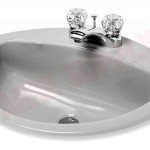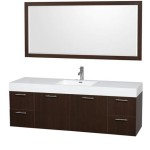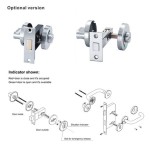Replacing a Drain Under a Bathroom Sink
A leaky or clogged drain under a bathroom sink can quickly become a nuisance, affecting functionality and even posing a risk of water damage. Fortunately, replacing the drain is a relatively straightforward plumbing project that most homeowners can tackle with the right tools and instructions. This article offers a step-by-step guide to replacing the drain under a bathroom sink, outlining the necessary tools, materials, and procedures to ensure a successful repair.
1. Gather the Necessary Tools and Materials
Before embarking on any plumbing project, it's critical to have the right tools and materials at hand. For replacing a bathroom sink drain, the following are essential:
- Adjustable wrench
- Channel-lock pliers
- Slip-joint pliers
- Screwdriver (Phillips and flathead)
- Plumber's tape
- Basin wrench
- New drain assembly (including tailpiece, trap, and strainer)
- Replacement nuts and washers
- Bucket
- Shop towels
It is recommended to purchase a high-quality drain assembly made from corrosion-resistant materials like brass or stainless steel. The new drain assembly should include the tailpiece, trap, and strainer, ensuring a complete and effective replacement.
2. Disassemble the Existing Drain Assembly
Once you have gathered the necessary tools, it's time to disassemble the old drain assembly. Follow these steps carefully:
-
Turn off the water supply:
Locate the shut-off valve for the sink and turn it off. -
Drain the sink:
Open the drain and let any remaining water drain out. You can use a bucket to collect the water if necessary. -
Remove the strainer:
Unscrew the strainer from the drain opening using the channel-lock pliers or a wrench. -
Disconnect the tailpiece:
Locate the tailpiece, which connects the trap to the drainpipe below the sink. Use the adjustable wrench to loosen and remove the tailpiece nut from the trap. -
Loosen the trap:
The trap is the curved pipe that prevents sewer gases from entering the house. Depending on the type of trap, you may need to use a basin wrench to loosen the nuts connecting the trap to the tailpiece and the drainpipe. -
Remove the old drain assembly:
Once all connections are loosened, carefully remove the old drain assembly.
During this process, keep in mind that the drainpipe under the sink may be older and brittle. Be cautious while disconnecting the assembly to avoid damaging the drainpipe.
3. Install the New Drain Assembly
With the old drain assembly removed, you are ready to install the new one. Follow these steps:
-
Connect the tailpiece:
Wrap the threads of the new tailpiece with plumber's tape to ensure a watertight seal. Connect the tailpiece to the trap, tightening the nut by hand. Ensure the tailpiece is positioned correctly to fit the drainpipe below the sink. -
Connect the trap:
Connect the trap to the drainpipe below the sink, tightening the nut by hand. If necessary, use a basin wrench to access the nut from underneath the sink. -
Install the strainer:
Install the new strainer by screwing it into the drain opening. Hand-tighten it first, then use the channel-lock pliers or wrench to tighten it securely. -
Test for leaks:
Once the new drain assembly is installed, turn the water supply back on and carefully check for any leaks. If you notice any leaks, tighten the connections again or re-apply plumber's tape to ensure a proper seal.
After successfully installing the new drain assembly, it is crucial to test it thoroughly to ensure that it is functioning correctly and there are no leaks. Be patient and double-check all connections to avoid any future complications.
4. Maintain Your New Drain
To prevent clogs and ensure your new drain assembly lasts longer, good maintenance practices are essential. Here are a few tips:
-
Run hot water periodically:
This helps flush away any debris or buildup in the drain. -
Use a drain cleaner ( sparingly):
Commercial drain cleaners can dissolve clogs, but overusing them can damage the drainpipe. -
Avoid pouring grease or hair down the drain:
These substances can solidify and cause clogs. -
Clean the strainer regularly:
Remove and clean the strainer to prevent debris from clogging the drain.
By implementing these maintenance strategies, you can extend the lifespan of your newly replaced drain assembly and prevent future plumbing issues.

How To Replace A Rusty Sink Drain Howtolou Com

Bathroom Sink Drain Leaking Around Threads Premier Plumbing Inc

How To Replace A Drain In The Bathroom Sink Right Way

How To Replace A Bathroom Sink Drain
How To Install Bathroom Sink Drain Queen Bee Of Honey Dos

How To Install Bathroom Sink Drain Plumbing Replace

How To Install A Pipe From Sink Drain Wall Ehow

Bathroom Sink Drain Leaking Around Threads Premier Plumbing Inc

Bianchina Swapping Out A Bathroom Sink Drain And Pop Up

How To Fix A Leaking Bathroom Sink Paschal Air Plumbing Electric
Related Posts







